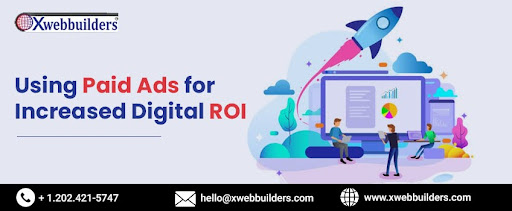
September 01, 2025

In today’s highly competitive digital landscape, businesses continually seek ways to maximize their return on investment (ROI). One powerful strategy for achieving this is through paid advertising. When executed correctly, paid ads can significantly enhance your digital ROI by driving targeted traffic, generating leads, and boosting conversions. This blog by our PPC services company in Ashburn USA, will explore the various aspects of using paid ads to increase digital ROI, including the different types of paid ads, best practices for creating effective campaigns, and the metrics to track for measuring success.
Paid advertising involves paying to display your ads on various digital platforms, such as search engines, social media networks, and websites. The primary goal is to reach a larger audience quickly and effectively, increasing brand visibility and driving conversions. There are several paid ad types, each with unique features and benefits.
Search engine advertising, or pay-per-click (PPC) advertising, involves placing ads on search engine results pages (SERPs). When users enter relevant search queries, your ads appear at the top or bottom of the SERPs, increasing the likelihood of clicks and conversions. Google Ads is the most popular platform for search engine advertising, offering extensive targeting options and robust analytics.
Social media advertising allows businesses to target users on platforms like Facebook, Instagram, Twitter, LinkedIn, and Pinterest. These platforms offer highly specific targeting options based on demographics, interests, and behaviors, enabling advertisers to reach their ideal audience. Social media ads can take various forms, including images, videos, carousels, and sponsored posts.
Display advertising involves placing visual ads on websites, apps, and social media platforms. These ads can be in the form of banners, images, or videos and are typically displayed on websites that are part of an ad network, such as Google Display Network. Display ads effectively increase brand awareness and retarget users who have previously interacted with your website or products.
Native advertising refers to ads that blend seamlessly with the platform content on which they appear. These ads are designed to match the look and feel of the surrounding content, making them less intrusive and more likely to engage users. Native ads can be found on social media platforms, news websites, and content discovery networks.
Successful paid ad campaigns require careful planning, strategic execution, and continuous optimization. Here are some best practices to help you achieve the best possible results:
Before launching a paid ad campaign, defining clear objectives is crucial. Are you looking to drive traffic to your website, generate leads, increase sales, or boost brand awareness? Specific goals will help you tailor your ad strategy and measure success accurately.
Understanding your target audience is essential for creating ads that resonate. Conduct thorough research to identify your ideal customer's demographics, interests, and behaviors. Use this information to craft compelling ad copy and visuals that speak directly to their needs and preferences.
The quality of your ad visuals and copy can significantly impact their effectiveness. Use high-quality images and videos that capture attention and convey your message. Craft compelling ad copy that highlights the benefits of your products or services and includes a strong call-to-action (CTA) to encourage users to take the desired action.
Your ad campaigns should direct users to optimized landing pages that provide a seamless and relevant experience. Ensure your landing pages are visually appealing, load quickly, and include clear CTAs. The content on the landing page should align with the ad copy to maintain consistency and drive conversions.
Most paid ad platforms offer advanced targeting options that allow you to reach specific audience segments. Use these features to target users based on demographics, interests, behaviors, and even past interactions with your brand. The more precise your targeting, the higher the likelihood of reaching users who are genuinely interested in your offerings.
Continuous monitoring and optimization are crucial for the success of your paid ad campaigns. Use analytics tools to track key metrics such as click-through rates (CTR), conversion rates, cost per click (CPC), and return on ad spend (ROAS). Based on these insights, make necessary adjustments to your ad copy, visuals, targeting, and bidding strategies to improve performance.
To determine the effectiveness of your paid ad campaigns and ensure a positive ROI, it’s essential to track and analyze various performance metrics. Here are some key metrics to monitor:
CTR measures the percentage of users who click on your ad after seeing it. A high CTR indicates that your ad is relevant and engaging to your target audience. To calculate CTR, divide the number of clicks by the number of impressions and multiply by 100.
Conversion rate measures the percentage of users who take the desired action (e.g., purchasing and filling out a form) after clicking on your ad. A high conversion rate indicates that your ad and landing page effectively drive users to action. To calculate the conversion rate, divide the number of conversions by the number of clicks and multiply by 100.
CPC measures the average cost you pay for each click on your ad. It’s an essential metric for managing your ad spend and ensuring that your campaigns are cost-effective. To calculate CPC, divide the total cost of your campaign by the number of clicks.
ROAS measures the revenue generated from your ad campaigns relative to the amount spent. It’s a critical metric for evaluating the overall profitability of your campaigns. To calculate ROAS, divide the total revenue generated by the total ad spend. A ROAS greater than 1 indicates a positive return on investment.
CPA measures the average cost of acquiring a new customer or lead through your ad campaigns. It’s an essential metric for assessing the efficiency of your campaigns in driving conversions. To calculate CPA, divide the total cost of your campaign by the number of conversions.
To further maximize the ROI of your paid ad campaigns, consider implementing advanced strategies and techniques:
Retargeting, also known as remarketing, involves displaying ads to users who have previously visited your website or interacted with your brand. Retargeting helps keep your brand top-of-mind and encourages users to return and complete the desired action. Use retargeting to re-engage users who abandoned their shopping carts or didn’t convert on their first visit.
Lookalike audiences are a powerful way to expand your reach by targeting users who share similar characteristics with your existing customers. By leveraging data from your customer base, ad platforms can identify and target new users likely to be interested in your products or services.
A/B testing involves your PPC Services Company creating multiple versions of your ads and comparing their performance to determine which is more effective. Test different ad copy, visuals, CTAs, and targeting options to identify the best-performing elements. Use the insights gained from A/B testing to optimize your campaigns continuously.
Paid advertising is a powerful tool for increasing digital ROI when used strategically. Businesses can achieve significant returns on their ad spend by understanding the different types of paid ads, following best practices for creating effective campaigns, and continuously monitoring and optimizing performance. For more information or to avail of services of our Best PPC Company Ashburn USA, visit Xwebbuilders.com.